In the January interview, Gosia Piatek of Kowtow had ‘nominated’ the French brand of sustainable footwear Veja but not being available for the interview because of the tight deadline, we decided by mutual agreement to orient ourselves towards Aquafil, the Italian textile company producer of regenerated ECONYL® nylon, a material we have talked about several times and of which several eco-sustainable designers make use (including Gosia Piatek for the Kowtow swimwear line).
It seems to me a good thing to have an Italian excellence as a guest and I must say that it is also the first time that the interview is on behalf of the company and not of an individual. And I like to add that, fresh news, Aquafil will also be present at the gala event that precedes the Oscar night (to be held tomorrow) with a luxurious carpet made of ECONYL® yarn. Wow!
Aquafil, whose history is half a century old, is now a textile giant, with offices all over the world and a vast and varied production of synthetic yarn both for clothing and for textile flooring. But when did the path to sustainability start? And with which step?
Aquafil has always been very sensitive to the theme of recycling and the journey to get to produce a 100% recycled waste yarn has been very long. The first step in the name of sustainability was moved back in 1990 when we started to recover and reuse some waste that was part of our polymerization process. Subsequently, in 1998, the recovery of waste material within the Group, for the production of techno-polymers, began.






Post – consume waste materials
Finally, in 2007 the production of a first recycled yarn was started up until the construction of an industrial plant in 2011 which chemically manages to transform waste and nylon 6 waste into raw material that has the same characteristics as that from oil. Thanks to this system, ECONYL® yarn production began, a 100% recycled material from both pre and post-consumer nylon waste. Our goal is to increase the percentage of post-consumer waste more and more.
On your site, I read that you recognize sustainability as a central part of your development strategy, so that you act on a set of guidelines, rationalized under the name of The Eco Pledge. Can you explain them to eco-à-porter readers?
For Aquafil, sustainability is not a result to be achieved but a way of thinking, a way of being, a principle that must constantly guide us. We believe that the only way that a company has to last over time is to grow in harmony with the surrounding territory and communities, respecting the environment and natural resources. We recognize sustainability as a central part of our development strategy. For this reason we act on the basis of a series of guidelines, which are under the name of THE ECO PLEDGE, expression of a new way of doing business based on innovation, respect for the environment and people.
The principles that guide us are:
- To design products that are more and more environmentally friendly, while reducing the environmental impact of production activities;
- To Draw motivation from those clients who make sustainability their development strategy;
- To create and maintain good relationships with the communities in which the Group operates and intends to grow in the future, by strengthening links in each territory.
They seem to me excellent principles. As regards the production, I would like to focus on the ECONYL® nylon regeneration project, which we have already talked about here in the occasion of the World Oceans Day and in a post dedicated to a swimwear brand that uses ECONYL®. When and how was this project born? And what are the steps to transform nylon into regenerated yarn?
The idea started thanks to the intuition of the President of Aquafil, Giulio Bonazzi, who has always had a very clear vision of how the company must be. The project is therefore part of a very precise strategy of transforming an entire business from linear to circular, also because we believe this is the only way to prosper and keep up with the challenges of a rapidly changing market.
So a change that goes from the classic ‘take raw materials, produce products and throw them once they are no longer useful’ to ‘take waste, produce products and recover what would be destined for landfill’, so no longer using raw material from sources fossils. ECONYL® is in fact a regenerated nylon made entirely from nylon waste – like fishing nets recovered from aquaculture and from the seas and oceans, fabric scraps, old carpets destined for landfill – but with the same performance of the nylon produced by oil.


Recovered fishing nets … 

to produce ECONYL yarn
To produce the regenerated ECONYL® yarn, we start with the recovery of waste coming from landfills and from the oceans of the whole world; once collected they are cleaned and work begins to recover all the possible nylon. Through an innovative regeneration process, the nylon waste is then transformed until it returns to the raw material stage. ECONYL® regenerated nylon is then transformed into a perfect thread for the garment, carpet and textile flooring industries. Another interesting and exclusive feature of this yarn is that it can be regenerated indefinitely without ever losing quality, which means that it is possible both to create and buy new products without using new resources from fossil fuels. Finally, using waste to produce ECONYL®, there is the double advantage of using waste that would otherwise end up in landfills or in the environment, while avoiding the use of oil as a raw material.
Regarding the rest of the production, are you considering other possibilities of regeneration, perhaps on the same fabrics once they have reached the end of their life?
We give new life to all waste that contains a high percentage of nylon. In addition to fishing nets, old carpets and industrial waste, we are testing other nylon waste. Many of these scraps are made from mixed materials, we are trying to figure out how to separate nylon from other materials. This is part of our journey to give the opportunity to create products that are more and more environmentally friendly and with the possibility of being recycled indefinitely once they have reached the end of their life.
It is undoubtedly a fascinating journey. And as long-standing producers of yarns, how did you see the fashion system approach to sustainability change over time? Is there more demand for eco materials?
More and more fashion and interior designers are enthusiastic about the idea of using sustainable materials in their collections. They choose ECONYL® for both environmental performance and the exciting story behind the regenerated yarn. More than 500 fashion brands and more than 60 carpet manufacturers have already chosen ECONYL® and this gives a glimpse of excellent prospects.
In fact, I am familiar with many companies that make use of your ECONYL® yarn and I hope they are more and more! Now, this interview is structured so that my interviewee ‘nominates’ the next guest. Who do you want to ‘nominate’ and why?
We nominate two young Italian designers who are creating very beautiful clothes made with our regenerated ECONYL® yarn and with which we are very happy to collaborate. Tiziano Guardini, best emerging designer at the 2017 edition of the ‘Green Carpet Fashion Awards’ in Milan, creates unique garments combining couture processing techniques in search of more sustainable materials.
A-LAB Milano was born from the creativity of Alessandro Biasi who finds inspiration everywhere without forgetting the sartorial tradition. Tiziano and Alessandro are proof that the future of fashion is sustainable and we can not but be happy.
Great! Tiziano Guardini is a designer who eco-à-porter follows since the blog was opened, he was a guest of the interview in July 2018, we admire his work and we also wrote about his latest collection presented at the Milan Fashion Week just this week. Naturally, ECONYL® was one of the main materials of the collection!
So we choose A-LAB, a new reality for eco-à-porter, always looking for talented eco-designers. Thanks Aquafil.


![Mono[PA6] by Freitag, a prova di economia circolare](https://eco-a-porter.com/wp-content/uploads/2024/05/freitag_monopa6_hero_master_16zu9_fin_01.2_0-218x150.jpg)














